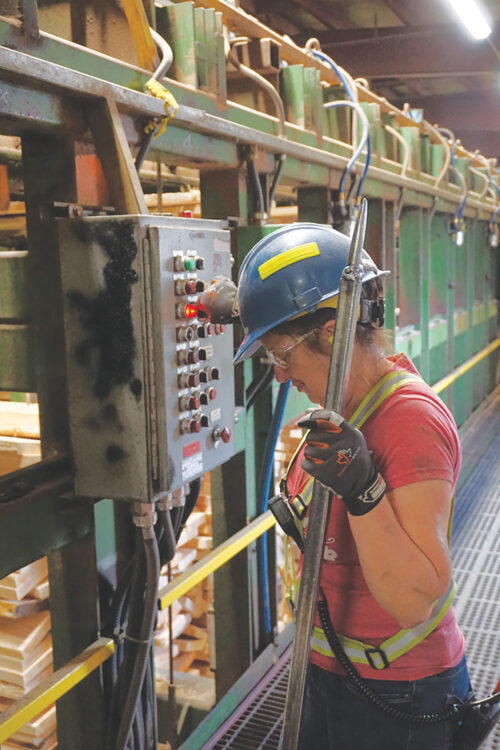
As the No. 1 preventable injury in a sawmill work environment, a risk-based approach to addressing hand safety hazards must be our first defense. Let’s explore the hierarchy of controls and best practices for protecting workers’ hands in sawmills, breakthroughs in safety psychology, such as nudge theory, and the importance of promoting a positive safety culture.
Work-related hand injuries are one of the leading reasons workers end up in the emergency room, but they can be prevented with effective safety measures and by following the hierarchy of controls – a safety management system that prioritizes the most effective ways to control hazards, starting with eliminating or substituting the hazard, then engineering controls, administrative controls, and finally, personal protective equipment (PPE). Let’s discuss how each of these controls can be applied to prevent hand injuries in sawmills.
Elimination/substitution
The most effective way to prevent hand injuries is to eliminate the hazard altogether. In sawmills, this may not always be possible, but some tasks can be substituted with less hazardous ones, reducing the risk of injury. For example, using an automated saw instead of a manual saw can significantly reduce the risk of hand injuries.
Engineering controls
Engineering controls involve designing equipment and processes to minimize the risk of injury. In sawmills, this may include installing guards on saws and other equipment to prevent contact with hands or designing machinery to minimize pinch points. Another example of an engineering control is installing safety interlocks on machinery.
Administrative controls
Administrative controls are policies and procedures that help to reduce the risk of injury. In sawmills, this can include proper training on machine operation and safety protocols, and job rotation to reduce repetitive motion injuries.
Personal protective equipment
Although PPE including gloves are the last line of defense against hand injuries, they can reduce injuries in your sawmill. Glove technology has come a long way in the last five to 10 years and completing a full glove assessment and implementing gloves with high puncture and cut resistance can greatly reduce the severity and frequency of injuries.
New breakthroughs
Nudge theory, a behavioural economics concept, has recently been incorporated into hand safety programs to improve hand safety. Nudge theory uses positive reinforcement to influence behaviour, such as providing feedback to workers on their safety performance. This method has been successful in encouraging workers to wear gloves and follow safety protocols.
Best practices in sawmills
To prevent various types of hand injuries, employers can implement a range of hand safety best practices. Here are some key recommendations:
- Conduct a hazard assessment to identify areas of the workplace where workers are at risk of hand injuries.
- Develop and implement a comprehensive hand safety program that incorporates the hierarchy of controls mentioned above.
- Implement engineering controls, such as guards on saw blades and safety interlocks on machinery.
- Conduct regular hazard assessments to identify areas of the workplace where workers are at risk of hand injuries.
- Look for and control physical hazards such as pinch points, sharp edges and unguarded chains and sprockets. For example: handrails near an operator can be a cause of many “struck by” hand injuries when using a pike pole.
- Management and safety committee members will want to perform workstation ergonomics assessments looking at tasks specific to material handling, hand placement and other situations that can lead to repetitive strain injuries.
- Develop and implement administrative controls, such as hand safety training programs, hand tool training, equipment inspections, and PPE/glove protocols.
- Working directly with a glove manufacturer, perform a full glove assessment across your company.
- Provide the correct gloves to workers and ensure they use them correctly and consistently.
- Ensure supervisors are inspecting their workers gloves at least weekly.
- Develop a culture of safety by encouraging workers to report hazards and incidents and involve them in the development of hand safety policies and procedures.
- Promote hand safety by introducing nudge-based interventions such as:
- Use colour-coded PPE that is specific to hand safety, such as gloves and sleeves. It can make it easier for workers to identify and use the appropriate equipment.
- Use visual reminders such as posters or signs that remind or warn workers about hand safety hazards in specific areas where hand injuries are prevalent and cannot be eliminated.
- Use positive reinforcement by recognizing workers who practice good hand safety habits. This nudge-based intervention can create a positive safety culture and help workers feel motivated to work safely.
Hand injuries in sawmills can be prevented by implementing effective safety measures and following the hierarchy of controls. Workers must be trained on safety protocols and provided with the necessary equipment and resources to reduce the risk of injury. New breakthroughs such as nudge theory and the promotion of safety culture can further improve hand safety in sawmills. Remember, preventing hand injuries is everyone’s responsibility, and together we can make sawmills safer places to work.
 Patrick McDonald is a safety specialist at Canfor, with over 15 years of experience working as a safety professional in Canada. He specializes in developing safety solutions in the industrial manufacturing industry.
Patrick McDonald is a safety specialist at Canfor, with over 15 years of experience working as a safety professional in Canada. He specializes in developing safety solutions in the industrial manufacturing industry.
Print this page
 Photo: Annex Business Media.
Photo: Annex Business Media.